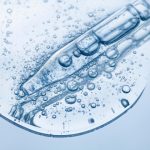Rejuvenating Skin with Hyaluronic Acid!
Product

Aging and exposure to other exposome factors decrease the production of Hyaluronic Acid. The free radical generation due to UV or other stress exposures also aids in the degradation of HA. The nutricosmetic effects of HA include: Moisturizing effect, Anti-ageing effect etc

Hyaluronic acid (HA), a linear glycosaminoglycan (GAG) constituted by repeating units of D-glucuronic acid and N-acetyl-D-glucosamine is an extracellular matrix (ECM) molecule widely distributed in connective tissues of most vertebrates. However, skin constitutes 50% of the total HA present in body. Though it is involved in numerus physiological functions such as joint lubrication, tissue repair, cell signaling, its protective role in skin as humectant has attracted great attention. It supports regeneration of skin through hydration as it can absorb water 1000 times of its volume. It is popularly used in numerous dermal and cosmetic formulations due to its: Hygroscopicity; Non-immunogenicity; Viscoelasticity; Biocompatibility.
The nutricosmetic effects of HA include:
Moisturizing effect
Anti-ageing effect (Firmness & Radiance)
Skin protection and healing
Repairing Alcoholic-skin damage
Collagen stimulation
Anti-erythema
Skin augmentation

Why formulate HA products when body synthesizes it?
Ageing and exposure to other exposome factors decreases the production of HA. The loss of epidermal HA is much higher than dermal HA with aging. In skin, the turnover rate of HA is also less than a day, which can get reduced further. The free radical generation due to UV or other stress exposures also aids in degradation of HA. For countering all these factors which drive degradation of HA, replenishment through HA rich skincare products is an effective approach. The market for HA was assessed at 8.9 billion USD in 2021, and it is anticipated to increase at a compound annual growth rate (CAGR) of 7.45%
Challenges to encounter for an effective HA formulation
Though incorporating HA as a part of skincare regimen can go a long way in maintaining healthy plump and dewy skin, there are several aspects which need to be taken care of.
Stability of HA
HA is a highly sensitive molecule which can undergo various chemical reactions viz. crosslinking, oxidation, hydrolysis. Thus, its properties are easily altered on exposure to environmental conditions of light, oxygen, temperature, pH or reactions with other ingredients. Therefore, preparation with right ingredients, stabilizers, and storage in optimal conditions is a prerequisite for achieving stability.
Selection of right molecular weight of HA
Being a polymer, HA can have a myriad range of molecular weights (103 ~ 107 Dalton or higher) and it greatly affects its physico-chemical properties. Though molecular weight is inversely proportional to penetration power through skin, selecting the right grade and molecular weight of HA for effective absorption remains very critical. The very high molecular weight HA (>1000 kDa) are retained on the surface and do not penetrate through the skin. Hence, lower molecular weight HA (20–300 kDa) are generally preferred for skin formulations as they can pass through the barrier of stratum corneum. However, the high penetration power of very low molecular weight HA (<5 kDa) can be detrimental especially for compromised skin as other impurities, microbes, irritants can pass along HA
Choosing native or derivatized forms
The choice of native form, sodium or potassium salts, hydrolyzed or other derivatized forms remains critical for formulation as it regulates its properties and thus, impacts its effectiveness. The selection can be made depending on the skin type of intended application. For instance, hydrolyzed forms are suggested for oily skin while sodium acetylated forms are preferred for dry skin. On a generic format, sodium hyaluronate constitutes majority (>90%) of the commercial products while HA accounts for <5%.
Optimal viscosity
Achieving the desired viscosity based on the nature of formulated product is another key area which needs to be addressed with right expertise. As discussed previously, the range of molecular weight used in formulation impacts the viscosity regulation as a high molecular weight HA will make product more viscous and vice versa for low molecular weight formulations. Additionally, interaction with other ingredients such as surfactants, penetration enhancers, emulsifiers, chelators, cross-linking agents can also modify the viscosity which might affects it utility. For instance, HA products in gel form might not remain acceptable for oily skin types if their viscosity is too low while lotions with very high viscosity will not be preferred by dry skin types. Thus, appropriate viscosity modifiers might be incorporated depending on the required attributes.
Combining with other right actives for enhanced skin care
Since properties of HA can be easily modulated by using its derivatized forms or employing a specific range of molecular weights, its potential in formulating cosmeceuticals with unique advantages is immense. However, expertise is required in using the optimal concentration and right combinations, and if formulated correctly they can be a viable solution for many specific skin concerns. For instance, incorporation of HA in sunscreens can provide enhanced anti-inflammatory advantage as HA addition helps to inhibit mutation in HA synthase, which limits flaring up of proinflammatory mediators. Similarly, it can be combined with retinol, niacinamide, Vitamin C, peptides etc. which will provide many advantages such as enhanced skin hydration, improved elasticity, reduced redness, skin brightening, reduction in age spots to contribute to comprehensive and healthy skin care.
What do we offer?
Our in-house R&D developed HA formulations offer solutions to all the above concerns. This potent bioactive is prepared in versatile forms i.e. gels, lotions, creams, serums etc. in indigenous novel technological formulations which ensure stability with optimal efficacy. The contaminant free high-quality and optimal grade of HA in concentrated individual forms as well as exquisite combinations are formulated with great precision for multi-faceted dermal applications.